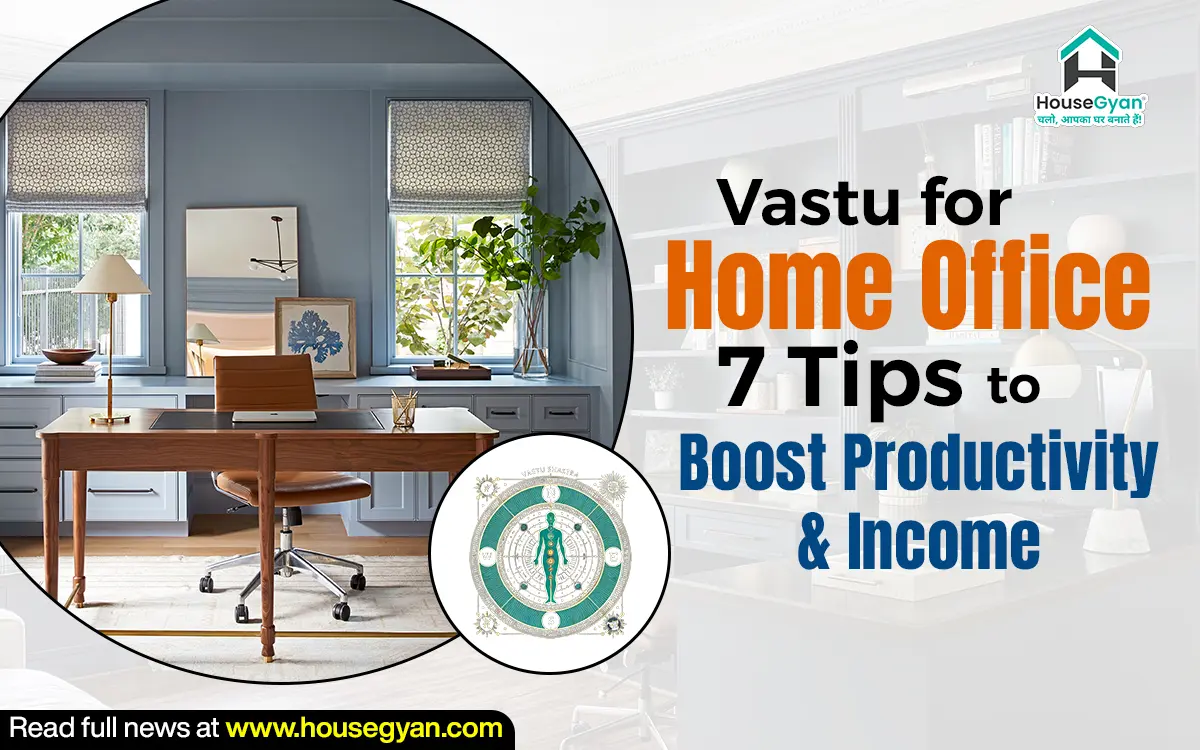Vastu Shastra
Read articles related to Vastu Shastra Home Design
Filter by Category
Toilet Vastu
Home Vastu
Staircase Vastu
Bedroom Vastu
Dinning Room Vastu
Drawing Room Vastu
Kitchen Vastu
Pooja Room Vastu
Recent blogs
House Gyan all services
Loading...Exploring Vastu Shastra: Harmonizing Your Living Spaces
Vastu Shastra, an ancient Indian architectural science, is more than just a set of guidelines; it’s a profound philosophy that harmonizes living spaces with natural energies. Rooted in traditional wisdom and cosmic principles, Vastu Shastra enhances the quality of life by creating balanced environments where positivity thrives.
What is Vastu Shastra?
Vastu Shastra, literally translating to "science of architecture," is a comprehensive system that dictates the design, layout, and spatial geometry of buildings. It integrates principles of direction, placement, and energy flow to create spaces that resonate with harmony and well-being. By aligning physical structures with cosmic energies, Vastu Shastra aims to optimize health, wealth, and happiness for its inhabitants.
Vastu Shastra for Home: Key Principles for a Harmonious Living Space
Vastu Shastra for house plays a vital role in designing a home that fosters positivity, harmony, and well-being. Incorporating Vastu Shastra principles ensures that every aspect of your home aligns with natural forces, bringing balance and prosperity. From selecting the right plot to designing your interiors, Vastu Shastra home design guidelines offer insights to create a peaceful and prosperous living environment, making your house a true haven.
Core Principles of Vastu Shastra
1. Directions (Disha)
Directions play a crucial role in Vastu Shastra, as each direction is associated with specific energies and deities. For instance, the north is linked with prosperity and wealth, while the east symbolizes enlightenment and vitality. Proper orientation of rooms and entrances according to these directions ensures the flow of positive energy throughout the home.
2. Five Elements (Panchabhutas)
The foundation of Vastu Shastra rests on the balance of five elements—earth, water, fire, air, and space. Integrating these elements into architecture ensures a harmonious environment. For example, using natural materials like wood and stone connects the building to the earth element, promoting stability and grounding.
3. Energy Flow (Vastu Purusha Mandala)
According to Vastu Shastra, every site has its own cosmic energy grid known as the Vastu Purusha Mandala. This grid determines the placement of rooms and structures within the building. By aligning with this grid, architects and homeowners can optimize energy flow and enhance the well-being of occupants.
Applying Vastu Shastra in Your Home
- Entrance and Main Door
The main entrance, often called the "mouth of the house," is crucial in Vastu Shastra. It should ideally face auspicious directions like east or north to invite positive energies into the home. A well-designed entrance promotes health, prosperity, and overall well-being for the residents.
- Interior Layout and Room Placement
Each room’s function and placement are meticulously planned in Vastu Shastra to maximize positive influences. For instance, the kitchen, representing the element of fire, is ideally placed in the southeast corner to harness its beneficial energies for nourishment and vitality.
- Colors, Décor, and Materials
Color schemes and interior décor also play a vital role in Vastu-compliant homes. Colors are chosen based on their associations with the elements and directions to create a balanced ambiance. Natural materials such as wood and clay are preferred for their grounding properties and connection to nature.
- Remedies and Corrections
In cases where Vastu guidelines are challenging to implement due to architectural constraints, remedies and corrections can be applied. These may include using Vastu yantras, symbols, or rearranging furniture to mitigate negative energies and enhance positivity.
Benefits of Vastu-Compliant Living
- Health and Well-being
A harmoniously designed Vastu-compliant home promotes physical health and mental well-being by balancing energies and reducing stress.
- Prosperity and Success
Optimized energy flow encourages financial stability and success in personal and professional endeavors for the occupants.
- Harmonious Relationships
Positive vibrations created by Vastu-compliant spaces foster harmonious relationships among family members, enhancing unity and emotional bonding.
Why Choose housegyan for Vastu Guidance?
At housegyan , we are dedicated to demystifying Vastu Shastra and empowering you to create spaces that resonate with positivity and harmony. Our expert articles, personalized consultations, and curated resources provide practical insights and guidance on integrating Vastu principles into your home design. Trust us to help you embark on a journey towards a balanced and prosperous life through Vastu Shastra.
Explore the transformative power of Vastu Shastra with housegyan, where ancient wisdom meets modern living for a harmonious tomorrow.
FAQs for Vastu Shastra
1. What is Vastu Shastra?
Vastu Shastra is a traditional Indian system of architecture that integrates natural elements, directional alignments, and spatial geometry to create harmonious living environments.
2. How does Vastu Shastra affect my home?
Applying Vastu principles can enhance positive energy flow, improve health, relationships, and financial stability, and foster overall well-being within the home.
3. Is Vastu Shastra applicable only in India?
No, Vastu Shastra principles can be applied globally, irrespective of geographical location, to create balanced and harmonious living spaces.
4. What are the basic principles of Vastu Shastra for homes?
Key principles include:
Directional Alignment: Ensuring rooms and entrances are aligned with favorable directions.
Room Placement: Assigning rooms based on their purpose (e.g., kitchen in the southeast, bedroom in the southwest).
Shape and Design: Favoring square or rectangular shapes for rooms and plots.
Natural Elements: Incorporating elements like sunlight, air, and water to enhance positivity.
5. Can I apply Vastu Shastra to an existing home?
Yes, Vastu principles can be implemented in existing homes through renovations, rearranging furniture, and making minor adjustments to align with favorable directions and placements.
6. Which direction should the main entrance of my house face?
The main entrance should ideally face the north or east direction to attract positive energy and prosperity.
7. What is the significance of the northeast corner in Vastu Shastra?
The northeast corner, known as 'Ishan,' is considered highly auspicious. Keeping this area open and clutter-free allows the entry of beneficial energies, promoting health and prosperity.
8. How should I position my bed according to Vastu?
It is recommended to sleep with your head facing south or east, as this alignment is believed to promote better health and restful sleep.
9. Is it necessary to follow Vastu Shastra when building a new home?
While not mandatory, adhering to Vastu principles during construction can lead to a more harmonious living environment, potentially enhancing the well-being of its occupants.
10. Can Vastu Shastra be applied to rented properties?
Yes, Vastu principles can be applied to rented properties by making adjustments such as rearranging furniture, using appropriate colors, and ensuring proper ventilation to enhance positive energy flow.
11. How does Vastu Shastra affect home design?
Vastu Shastra emphasizes the correct placement and orientation of rooms, doors, and windows to bring positive energy, happiness, and prosperity into the home.
12. Can Vastu Shastra be applied to modern homes?
Yes, Vastu Shastra can be adapted to suit modern home designs, ensuring that the principles of energy flow and natural balance are respected while incorporating contemporary aesthetics.
13. How can I incorporate Vastu in my home construction?
You can incorporate Vastu by following guidelines for room placement, furniture arrangement, door orientations, and other key elements that align with the flow of energy.

The information contained on Housegyan.com is provided for general informational purposes only. While we strive to ensure that the content on our website is accurate and current, we make no warranties or representations of any kind, express or implied, about the completeness, accuracy, reliability, suitability, or availability with respect to the website or the information, products, services, or related graphics contained on the website for any purpose. Housegyan.com will not be liable for any loss or damage including, without limitation, indirect or consequential loss or damage, or any loss or damage whatsoever arising from loss of data or profits arising out of, or in connection with, the use of this website.
Third party logos and marks are registered trademarks of their respective owners. All rights reserved.

















